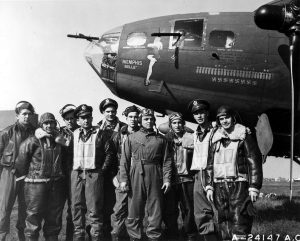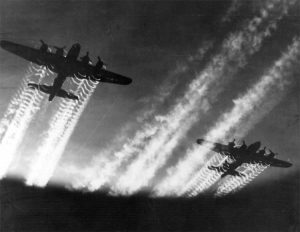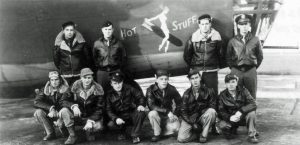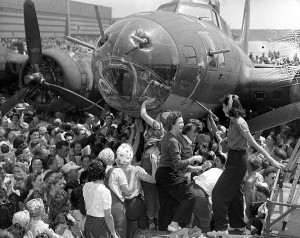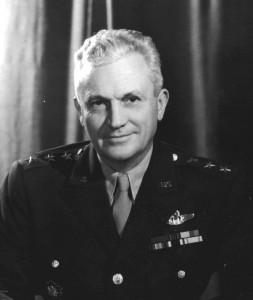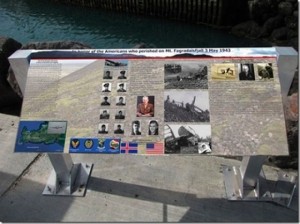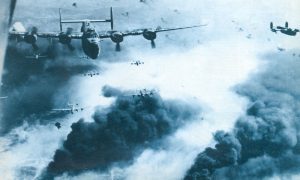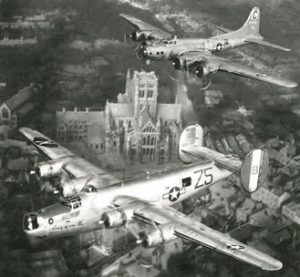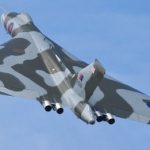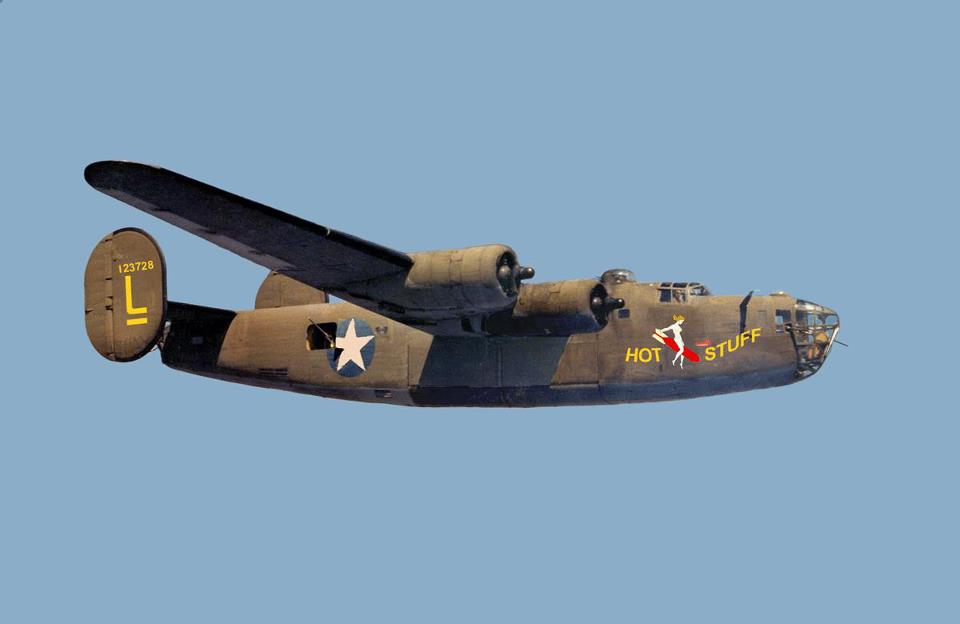
(Image Credit: B24HotStuff)
On a recent post here at Warbirds News, we reported on the anniversary of milestones in the history of what is perhaps one of the most famous bombers of all time, the Boeing B-17F Flying Fortress, Memphis Belle. In the article comments, we were contacted by Air Force veteran Jim Lux who stated “The first heavy bomber in the 8th Air Force to complete 25 mission in World War II was the B-24 Liberator Hot Stuff. It completed its 25th mission on February 7, 1943, three and a half months before the B-17 Memphis Belle.”
(Image Credit: USAAF)
While the article on Memphis Belle had included the qualifier “first B-17 United States Army Air Force heavy bomber to complete 25 combat missions with her crew intact,” which on a factual basis at least made the article “correct” insofar as it specified that it was the “first to 25 missions with her crew intact,” but the truth is, while we’re reasonably knowledgable about WWII lore here, the name “Hot Stuff” didn’t spark any particular recollection in us or among the several other warbird enthusiasts we asked about it, though one fellow we spoke to did remember it as the plane General Andrews lost his life in, but generally there wasn’t much recognition. That in mind, we’d like to try set the record straight, though the waters in this case are especially muddy.
(Image Credit: USAAF)
In 1942, during the first three months of America’s combat flights over Europe the average bomber crew was expected to complete 8-12 missions before being shot down or disabled. This in mind, the US Army Air Force decided that 25 missions while serving in a heavy bomber of the 8th Army Air Force would constitute a “completed tour of duty” because of the “physical and mental strain on the crew.” While the 25 Mission edict was a tall order when it was made, it was a number crews could believe in, and provided some hope of a light at the end of the tunnel, particularly necessary with the grim statistics bomber crews faced early-on, before long-range fighter escorts significantly improved mission survivability when they arrived later on in the course of the conflict.
(Image Credit: USAAF)
The 25-mission milestone becomes harder to pin down when considering changing crew members due to rotation, death, injury, illness, leave and equipment failures leading to spare planes pressed into service, errant wartime record-keeping, etc. Setting aside all the caveats for the moment, the research performed and documentation provided by Jim Lux seems to conclusively show that the 93rd Bombardment Group, 330th Bombardment Squadron’s B-24 Liberator Hot Stuff and her crew flew their 25th mission on February 7, 1943 dropping bombs on Naples, Italy, and went on to fly five additional missions thereafter, before Hot Stuff and her crew were recalled to the United States, where they were scheduled to go on a War Bonds Tour, a home front publicity junket, where combat aircraft and crews of significant accomplishment were sometimes pulled from frontline service and flown back to the United States to serve as the stirring personification of the heroism of America’s military, helping move the paper and boosting public morale.
(Image Credit: Los Angeles Daily News Archive/ UCLA)
The 303rd Bombardment Group 358th Bombardment Squadron, B-17F Flying Fortress Hell’s Angels, after which the Group later named itself, completed its 25th mission on May 13, 1943. It became the first 8th Air Force B-17 to complete 25 combat missions and at the end of their tour, the crew of Hell’s Angels signed on for a second and continued to fly, going on to fly 48 missions, without ever turning back from their assigned target no less, before the aircraft was returned to the states on January 20, 1944 for its own publicity tour.
The 91st Bombardment Group, 324th Bombardment Squadron’s B-17F Flying Fortress Memphis Belle’s crew flew their 25th combat mission on May 17, 1943, against the naval yard at Lorient, France. Interestingly, this raid was the Belle’s 24th combat mission as the original crew occasionally flew missions on other planes and other crews took the Belle on missions as well. Those uncertainties aside, on May 19, the Memphis Belle flew its 25th combat mission on a strike against Kiel, Germany, though manned by a different crew. Those who flew the Memphis Belle did seem to have particularly good luck though as none of her crew died or was significantly injured on her missions, despite being routinely riddled with bullets and damaged by flak, reportedly going through 9 engines, both wings, two tails, and both main landing gear assemblies over the course of her seven month combat career.
(Image Credit: US Army)
The story of Hot Stuff, heading home at last after at least 30 missions completed, ends in tragedy. The plane and her crew was on the return flight to the states for a War Bonds publicity and morale-boosting tour on May 3, 1943, and Lieutenant General Frank M. Andrews, Commander of the European Theater of Operations needed to get back the the states as he had been summoned to Washington DC by the General of the Army, George Marshall. Andrews and his entourage hitched a ride on Hot Stuff, and in doing so bumped five crew members from the flight. Though they were supposed to refuel at Prestwick, Scotland before heading out over the Atlantic, the crew elected to skip stopping at Prestwick and proceed to their next waypoint, Reykjavik, Iceland. They arrived to find the weather at their destination quite dicey with snow squalls, low clouds and rain. After several landing attempts, the B-24 crashed into the side of 1,600-foot-tall Mount Fagradalsfjall, near Grindavik, Iceland. Upon impact, the aircraft disintegrated except for the tail gunner’s turret which remained relatively intact and 14 of the 15 aboard died except the tail-gunner who, though injured, survived the crash.
(Image Credit: B24HotStuff)
Hot Stuff and her crew were soon forgotten. Lieutenant General Andrews is remembered however, Joint Base Andrews in Maryland is named in his honor. Discovering the historical discrepancy in 1999 through a friend and fellow Commemorative Air Force member, USAF Major Robert T. “Jake” Jacobson, who was one of the bumped crew members that fateful night, Jim Lux began seeking to correct what he sees as an injustice perpetrated by history and is working on not only getting Hot Stuff and her crew their place in the history books, but is also working to have a monument erected near the site of the crash, enlisting the US Ambassador to Iceland, Luis E. Arreaga as a liaison to the Republic of Iceland and has gained the support of a growing number of other Air Force retirees who after seeing the documentation, agree that the crew of Hot Stuff is getting short shrift. Lux has also been in contact with the National Museum of the United States Air Force, turning over to them debris he recently retrieved from the site of the crash and is negotiating with the Smithsonian National Air and Space Museum for a Hot Stuff display. Last month, through his fundraising efforts, Lux returned to Iceland for a 70th anniversary memorial service attended by some of the descendants of the crew of Hot Stuff and a plaque was installed telling the story of Andrews, Hot Stuff and her last, ill-fated flight with a granite monument planned to be installed at a future date.
(Image Credit: USAAF)
Doubtless, Hot Stuff and her crew deserve to be remembered for their heroic accomplishment, as does the crew of Hell’s Angels, and all the other pilots and planes who served, regardless of circumstances of their sacrifice. That the Memphis Belle and her crew had a more storybook quality to their military careers that better fit with the narrative that the government desired for home-front consumption is obvious. After all the adversity, damage and close calls, no one was ever seriously injured, and her entire crew made it home. In fact, the mythic “Memphis Belle effect” was such that there wasn’t a death among those who had served on her for nearly 40 years after her last combat flight, in defiance of actuarial norms, and Americans, for better or worse are conditioned to respond to a happy ending, especially when it goes against all probability.
The old saw goes “the first casualty of war is truth,” and it is entirely likely that there were other planes and/or crews between Hot Stuff and Memphis Belle that completed the vaunted 25 missions that constituted a “completed tour of duty,” a bar that was moved at various times to 25, 30, and 35 missions, depending on the overall loss rates, the degree of mission difficulty, as well as the conditions that they were operating in. In the end the significance of specific mission counts are completely arbitrary. That the Memphis Belle story, though abetted by a government anxious to report uplifting and inspiring stories of the war to its people at home, captured the public’s imagination, doesn’t make the story any less inspiring and does not and should not be perceived as taking something away from the countless others who made sacrifices for their country, just as the recognizing the achievements of the crews of Hot Stuff and Hell’s Angels don’t diminish the sacrifices made by those unfortunate souls who went down in flames whether on their first, fourth or 24th mission in service to their country.
There will always be those who subscribe to particular yardsticks though, so to summarize:
Hot Stuff was the first B-24/crew and the first “heavy bomber” to complete 25 missions on February 7, 1943.
Hell’s Angels was the first B-17/crew to complete 25 missions on May 13, 1943.
Memphis Belle’s crew completed 25 missions May 17, 1943 (without any loss of life).
Memphis Belle, the plane completed her 25th mission on May 19, 1943 (without any loss of life).
Those interested in Hot Stuff and/or are looking to support the erection of the Icelandic monument to the brave men who served on her can connect with the organization HERE or the group’s Facebook page.
More information on Hells’s Angels is available HERE.








